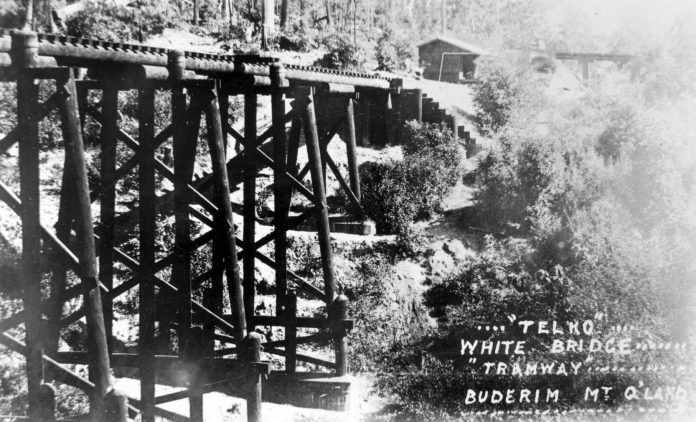The farmers of Buderim, struggling to get their bountiful crops to market, came up with the bold idea for a tramway – and fought hard to make it a reality.
For 21 years, Palmwoods would be the terminus for a link with the main North Coast railway.
In 1903, Buderim farmers approached Maroochy Shire Council for funds to construct a tramway to transport their produce to Woombye, or even the Diddillibah terminus of the Moreton Sugar Mills tramway.
They were unsuccessful and tried again in 1907, approaching the Queensland Treasury for help.
This time, they suggested building a line over one of the two formerly proposed routes but also came up with a third, Palmwoods. The Department of Agriculture turned them down.
Finally, in 1910, promoters convinced Mr Phillips, an engineer, to make a trial survey of a route between Palmwoods and Buderim.
The 83 ratepayers on the proposed benefit area were sure that their choice of route was right even though construction and running costs would be higher than a route to Nambour.
They asked Maroochy Shire Council to apply for a loan of £21,000 to cover plans, specifications and estimated costs of construction and balanced it against expected revenue.
Before the loan was approved in 1912, the Palmwoods to Buderim route was inspected by the Commissioner of Railways. The Chief Engineer in charge of railway surveys gave it his approval as “the most feasible from an engineering point of view”.
As the original loan was considered insufficient for construction and equipment, the Treasurer granted a loan of up to £26,500.
Resumptions, labour and materials proved more expensive than planned but the promoters still believed the line had to go through at all costs and the loan was increased by £3500 in 1914 – and again in 1915.
Difficulties were also experienced with linking the line to the government railway at Palmwoods, which helped inflate the loan to £36,000 pounds by the time the line was finally opened at the end of 1914.
The first locomotive, bought new from Krauss in 1914, was quite a large engine for a Queensland narrow gauge line but was efficient, economical and fast. The second, a Shay bought in 1915, was much larger and although powerful, was slow and heavy on coal.

The engines were black with red buffer beams and ran chimney first towards Buderim and last on the way back, as there was no way to turn them.
A passenger carriage had an interior arranged as a saloon with cushioned seats facing inwards. Windows were glazed and the ride was reasonably comfortable.
For the goods, there were four ton open wagons with drop sides for general merchandise and flat timber bolster wagons.
The late Bill Atkinson of Palmwoods, whose mother was the first postmistress/station mistress at Forest Glen, recalled that there was never a serious accident on the line, although, “one Saturday afternoon the guard’s van left the line at Cape Horn, the most southern part, and John Atkinson put it back on the rails and braked it down to Forest Glen”.
And once, while Mr Pope was working the little engine Kraus, he “placed the selector in the wrong way so that it went backwards when forward was selected”.
The tram made six trips a week and two extra fruit trips on Tuesday and Friday. During the strawberry season, there was a Saturday afternoon trip.
It’s safe to say the Buderim to Palmwoods Tramway was a key point in the development of Buderim’s fame as Queensland’s fruit basket and for the promotion of tourism on the Sunshine Coast.
It opened up the region to daytrippers, holiday-makers and, ultimately, urban development.
The line closed in 1935, and on its last journey down the hill, the rails were lifted and taken with it. The old route can still be explored today on a heritage walk.
Information: www.buderim.com/tramway
This flashback is brought to you by veteran Sunshine Coast journalist and history writer Dot Whittington, also the editor of Your Time Magazine.





